
The Manchester Regiment was a line infantry regiment of the British Army in existence from 1881 until 1958. The regiment was created during the 1881 Childers Reforms by the amalgamation of the 63rd Regiment of Foot and the 96th Regiment of Foot as the 1st and 2nd battalions; the 6th Royal Lancashire Militia became the 3rd (Reserve) and 4th battalions and the Volunteer battalions became the 5th, 6th, 7th, 8th, 9th and 10th battalions.
The King's Regiment, officially abbreviated as KINGS, was an infantry regiment of the British Army, part of the King's Division. It was formed on 1 September 1958 by the amalgamation of the King's Regiment (Liverpool) which had been raised in 1685 and the Manchester Regiment which traced its history to 1758. In existence for almost 50 years, the regular battalion, 1 KINGS, served in Kenya, Kuwait, British Guiana (Guyana), West Germany, Northern Ireland, the Falkland Islands, Cyprus, and Iraq. Between 1972 and 1990, 15 Kingsmen died during military operations in Northern Ireland during a violent period in the province's history known as "The Troubles".
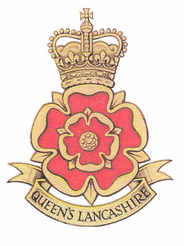
The Queen's Lancashire Regiment (QLR) was an infantry regiment of the British Army, part of the King's Division. It was formed on 25 March 1970 at Connaught Barracks in Dover through the amalgamation of the two remaining Lancashire infantry regiments, the Lancashire Regiment and the Loyal Regiment. In July 2006 the regiment was amalgamated with two other Northern infantry regiments to form the Duke of Lancaster's Regiment.

The South Lancashire Regiment was a line infantry regiment of the British Army in existence from 1881 to 1958.

The King's Own Royal Border Regiment was an infantry regiment of the British Army in existence from 1959 until 2006, and was part of the King's Division. It was formed at Barnard Castle on 1 October 1959 through the amalgamation of the King's Own Royal Regiment (Lancaster) and the Border Regiment.
The Lancastrian and Cumbrian Volunteers was a Territorial Army unit of the British Army.
The King's and Cheshire Regiment was a regiment of the British Territorial Army, with headquarters in Warrington, Cheshire.
The Liverpool Brigade, later 165th (Liverpool) Brigade was an infantry brigade of Britain's Volunteer Force that served during World War I with the 55th Division of the British Army. During World War II, again as part of the 55th Infantry Division, the brigade remained in the United Kingdom.
The 166th Brigade was an infantry brigade of the British Army that saw active service in the First World War and remained in the United Kingdom throughout the Second World War.
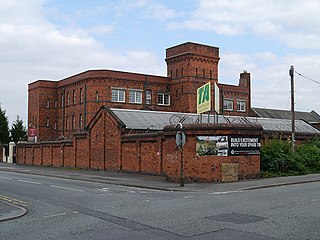
Peninsula Barracks is a military installation on O'Leary Street in Warrington, England.

The Castle Armoury is a former military installation in Bury, Greater Manchester, England.

The Phoenix Street drill hall is a former military installation in Lancaster, Lancashire.
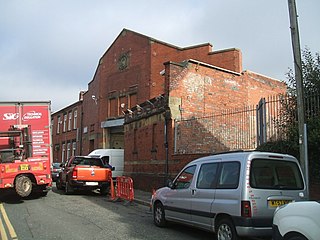
The Baron Street drill hall is a former military installation in Rochdale, England.

The Grange Road West drill hall is a former military installation, and now a sports centre, in Birkenhead, Merseyside.

The Canterbury Street drill hall is a former military installation in Blackburn, Lancashire. It is a Grade II listed building.
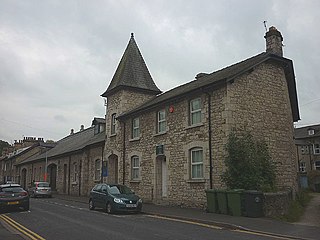
The Queen Katherine Street drill hall, sometimes known as the Aynam Road drill hall is a former military installation located on Queen Katherine Street, off Aynam Road, in Kendal, Cumbria, England.
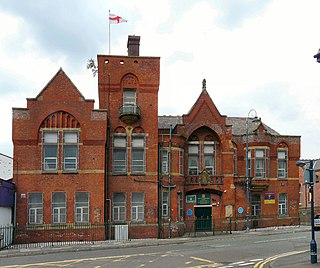
The Old Street drill hall is a former military installation in Ashton-under-Lyne, Greater Manchester, England.
The Lancastrian Volunteers was a short lived Territorial Army infantry regiment of the British Army, composed of companies from the North West affiliated regiments.

The 5th Battalion, King's Regiment (Liverpool) was a volunteer unit of the King's Regiment (Liverpool) of the British Army. It traced its heritage to the raising in 1859 of a number rifle volunteer corps in Liverpool, which were soon consolidated into the 1st Lancashire Rifle Volunteer Corps (RVC). It was affiliated to the King's Regiment (Liverpool), and became its 1st Volunteer Battalion of the regiment. In 1908 the battalion was transferred to the new Territorial Force as the 5th Battalion, King's Regiment (Liverpool). It saw active service on the Western Front during World War I, as did its second line second-line battalion, and even a garrison battalion. Before World War II it again formed a second line battalion. Both served in home defence, but the 5th King's landed in Normandy on D Day as part of a specialist beach group 1939. When the Territorial Army was reduced in 1967, the 5th King's became a company of the Lancastrian Volunteers.














